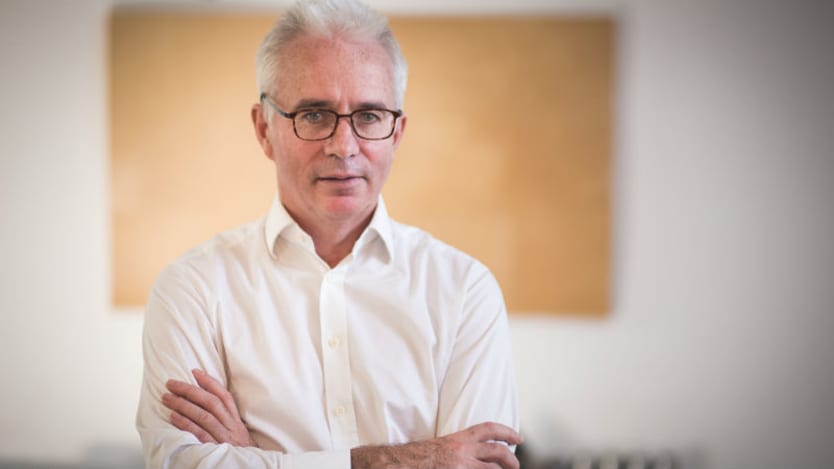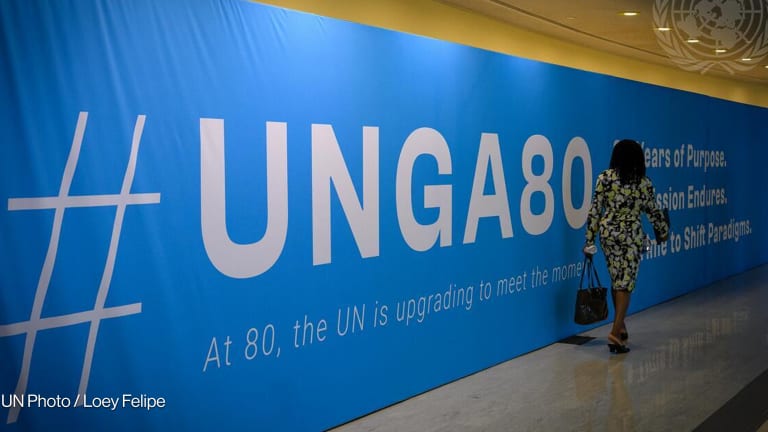
NEW YORK — In two weeks, the global health community will find out if it is still possible to achieve ambitious funding goals at a moment of multilateral disarray — and if so, how.
In Lyon, France, French President Emmanuel Macron will preside over the sixth replenishment conference of the Global Fund to Fight AIDS, Tuberculosis and Malaria — a global partnership that mobilizes more than $4 billion a year toward the treatment, control — and, perhaps, elimination — of three of the world’s deadliest diseases.
In January, the Global Fund launched its investment case, and set a target of $14 billion to support its work for the next three years. In recent months, country pledges have begun rolling in, with several major donors increasing their commitments over previous years, and several others coming on board for the first time.
With two weeks to go before the replenishment conference, Global Fund Executive Director Peter Sands was in New York during the United Nations General Assembly, working to rally support and make the case for investing in the fight against three global epidemics.
“I’m not going to count my chickens,” Sands told Devex in an interview. But he said the fund appears to be “in a pretty good place.”
Five of the G-7 largest economies in the world have made pledges to the fund. The only two remaining are France — which, as host of the replenishment, is expected to issue its pledge in Lyon — and the United States.
While U.S. President Donald Trump has proposed a contribution that is more than $400 million less than what the fund hopes to receive from the United States — while simultaneously proposing to sever a commitment to provide one-third of the fund’s overall funding — the U.S. Congress has flatly rejected that suggestion. Both the U.S. Senate and House of Representatives have put forward budget bills that include $1.56 billion for the Global Fund — though it appears unlikely those bills will pass before the pledging conference.
In the meantime, Sands has been drumming up support among some of the less prominent donors, whose support might mean the difference between a successful or disappointing visit to Lyon.
“Our focus here at the UNGA is very much on the large number of middle-sized donors — some of the other European countries, countries in the Middle East, countries elsewhere in the world,” Sands said.
“The investment case that we launched in January has had a very good reception. People aren’t arguing with us about the case. People understand the case is very compelling. It’s more a question of whether governments feel they have the money,” he added.
The Global Fund chief is also looking to the private sector. The fund has targeted $1 billion of the $14 billion to come from private sector contributions, but Sands pointed out that corporate support involves more than money. The Global Fund’s private sector partnerships allow it to tap the data analytics, supply chain, and market expertise that companies are often better positioned than governments to provide — a fact that Sands, a former banking executive, thinks the rest of the global health community needs to do a better job of recognizing and embracing.
“The global health community hasn’t done a particularly good job at engaging the private sector,” he said, describing the Global Fund as “more inclined to do more with the private sector than any other” global health institution.
“We’ve got to find a way of … being able to engage the private sector while simultaneously challenging and disagreeing with them.”
— Peter Sands, Global Fund“There’s a lot of mistrust and misunderstandings between the private sector and the global health community, and personally I think we need to find ways of changing that, because if we really want to accelerate progress towards the SDG 3 goals and UHC, I think we need the resources, skills, and capabilities of the private sector more actively engaged,” he said.
Sands contrasted the global health community’s reluctance to work with the private sector with the climate change community’s ability to engage companies as both critic and partner.
“What we’ve got to find a way of doing is being able to engage the private sector while simultaneously challenging and disagreeing with them,” he said.
“When I look at what the climate change community has done, it has actually reached out to power companies, mining companies, airlines, people who are actually, in some ways, causing quite a lot of the problem, and simultaneously worked with them and challenged them, and I would like to see us in the global health community doing more of that,” he added.
The Global Fund has actually examined this difference in approach. It looked into the percentage of Fortune 500 companies that have created corporate climate change and environmental strategies and metrics, and found that 72% of them had done so. Of those same companies, only 10% had created strategies and metrics for global health, Sands said, adding that if you removed pharmaceutical companies from that list, the number shrunk to basically zero.
“The reality is the climate change community and environment community worked with and challenged the corporate sector, and not just those directly involved in the environment, but all types of companies, to think about and get engaged with environmental issues,” Sands said.
“I don’t think we have yet managed to achieve that in the health arena,” he added.
Becoming more ambitious
The Global Fund estimates that with $14 billion it can save roughly 16 million lives, yet the three diseases it was created to fight still overwhelm health facilities in countries where the fund operates.
“Simply saving people’s lives from the three diseases, and then having them die of something else, clearly isn’t enough.”
— Peter Sands, Global FundSands noted that while the fund might have been created in a moment of emergency response to three global killers, it has already evolved significantly over the course of its 18-year lifetime.
“When the Global Fund was created in 2002, nobody was talking about ending the epidemics. People were just saying, we have a disaster on our hands. Stop so many people dying,” he said.
Now that the death rates of the three diseases have roughly halved, fund faces a broader and more complex challenge.
“We’ve now said it’s not enough to bring down the run rate of death. We’ve got to be more ambitious. We’ve got to end the epidemics, because actually, that is the way of saving countless future lives. That’s a big strategic shift,” Sands said.
With the global health community’s attention now focused on achieving the Sustainable Development Goals and building health systems, that evolution continues.
“Simply saving people’s lives from the three diseases, and then having them die of something else, clearly isn’t enough. We’ve got to work in a way that contributes to the broader goal of health and well-being and the broader functioning of the health system,” Sands said.
He highlighted three ways in which the Global Fund’s model positions it to contribute to the effort to achieve universal health coverage.
The first is the fund’s focus on marginalized populations, among whom AIDS, TB, and malaria are increasingly concentrated.
The second contribution is the Global Fund’s ability — by focusing on three high-burden disease epidemics — to “free health systems of burdens that, in many countries, still completely dominate and overwhelm everything that their health system is doing,” Sands said. He noted that in many places where the fund operates, health facilities purport to provide general health services are largely consumed with treating people with HIV.
Finally, Sands pointed to the potential for the fund to drive community engagement in building health systems. The Global Fund’s model includes country coordinating mechanisms, which endow disease-affected communities with responsibility for charting their own response. Representatives from these same countries sit on the Global Fund’s board, “with the same voting power as our largest donor,” Sands said.
Many of these countries — even though they are net recipients of funding, by a large margin — are now also donors to the Global Fund.
“Ultimately it is the countries, and the governments of those countries, that are going to defeat these epidemics, that are going to build UHC, that are going to deliver SDG 3. It’s not the multilaterals,” Sands said.
“The multilaterals can act as enablers, and can help, and absolutely we have an important role. But we need them to take ownership and leadership, and I think by them being involved in the way we are governed and funded, that’s part of that leadership,” he added.
Activism. UHC. Climate. Read more of Devex's coverage from the 74th U.N. General Assembly.








